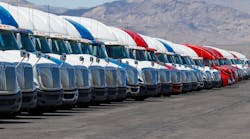It’s been a year since the pandemic hit the U.S., and freight growth is exceeding available capacity, with spot rates spiking and contract rates on the rise. Because of that, orders for new commercial trucks and trailers are strong, as fleets need more equipment to meet expanded hauling capacity needs. The problem, though, is original equipment manufacturers (OEMs) are struggling to keep up with demand.
OEMs are still experiencing supply chain challenges, explained Don Ake, vice president of commercial vehicles (CV) for FTR, during FTR’s recent Commercial Vehicle Quarterly Outlook webinar. In addition to worker shortages, imports are delayed because there is a bottleneck at the ports anywhere from two to three weeks, and there are various raw material shortages.
“Unfortunately, the supply chain issues may not get resolved soon,” Ake said. “In the past, there was always a plan for when things would come back. This time, not so much.”
In addition, fleets remain concerned about finding drivers for their additional trucks, since the pipeline for new drivers has been impacted by the virus. However, Ake explained the bright side is commercial trucking is trying to meet strong demand with constricted supply, not limited supply.
“It’s not that we’re running out of manufacturing capacity,” he said. “It’s that the capacity that we have is constricted by other factors. So, that’s great news. Once that bottleneck opens up, things are going to be great. Regardless of the bottlenecks, we will get through this because in this industry, we always do.”
CV forecasts
FTR reported that Class 8 net orders remained “impressive” in February for the fifth consecutive month, coming in at 44,000 units and representing a 209% year-over-year increase. Orders for the previous 12 months now total 338,000 units.
“Fleets need trucks, and they are ordering trucks,” Ake pointed out. “They can’t get trucks fast enough, so they are continuing to place orders hoping to get equipment that they need as soon as possible.”
That order activity, however, has created a serious backlog. Due to semiconductor and other component shortages, FTR projects a more gradual 2021 Class 8 outlook, where demand from the first quarter will be distributed to Q3 and Q4. “We kept Q2 the same because it was very high to begin with, and the OEMs are going to be challenged to meet that Q2 number,” Ake said.
Ake also anticipates build increases, but OEMs will ramp up production as fast as they can and then build at high rates throughout 2021. However, he stressed any orders that cannot be built will keep rolling over month-to-month.
Ake noted that the demand is there to produce more than 298,000 units in 2021, with strong forecasts for 2022 and 2023.
When it comes to trailers, in 2020, the CV industry hit record trailer orders. Orders were down in January, as some OEMs are booked solid for this year. Overall, FTR reports a trailer production forecast of up to 283,000 units for 2021.
“They can’t book anymore for this year; thus, orders are dropping,” Ake explained. “They will continue to drop but it doesn’t matter because when we look at the backlog – approaching the high numbers that we got in 2019. We’re probably going to hit that again, and we’re very close.”
Medium-duty segments remain a “mixed bag,” according to Ake.
“It’s very hard to grasp because there are so many sub-segments of medium-duty, and they all have been impacted a little differently by the pandemic,” he explained. “The more industrial-based the vehicle, the slower the recovery. Class 5 delivery vehicle demand is robust and holding up because it’s consumer-oriented. Class 6 recovery began in October and has been growing since at a pretty steady rate. Class 7, more industrial vehicles, are still subdued.”
Overall, Ake projected that 2021 will be a “great year for commercial equipment” and that the industry is “set up for very good things.”
Freight market outlook
The spot market has seen a huge spike in the spot loads getting posted, with a pressure in dry van and refrigerated freight, explained Eric Starks, FTR chairman and CEO.
“Rates are moving faster than normal seasonal behavior; they are not at quite record levels here, but we are getting very close,” Starks said. “We are significantly above where we would expect things to be in this time.”
He projected that growth will continue and more freight is expected, bringing added pressure to an already tight market. Because of that, Starks anticipates the industry will be at 100% active truck utilization in the next couple months.
“That means additional pressure on rates,” he said. “That also means that there could be supply chain challenges of getting things moved around the country and having it moved when you want. Everybody is going to be fighting for capacity. That doesn’t ease up as we move through the balance of the year.”
Starks also noted that in the latter part of 2020 into 2021 the industry has experienced a significant constraint for available truck drivers. Fleets will likely feel pressure from this driver crunch through 2022, he predicted.
In its latest Freight Forecast report, ACT Research pointed out that the recent COVID-19 stimulus package will only continue to drive the stronger freight rate cycles.
“Pushing commercial vehicle demand forward, freight rates ended February at record levels, seasonally adjusted, and started March on an upswing,” explained Tim Denoyer, ACT Research’s vice president and senior analyst. “With the nation’s ports backed up for months, commodity prices soaring, the manufacturing sector warming up, and the housing market already in full swing, there is unparalleled visibility to strong freight flows.”
Regarding the truckload spot rate market, Denoyer noted that ACT projects more increases on the horizon with a very strong freight volume pipeline and Class 8 production restrained by parts shortages.
“We see the latest federal COVID-19 relief package adding to both freight demand and the challenges of re-engaging supply, which presses our spot rate forecasts higher this month,” he added.




